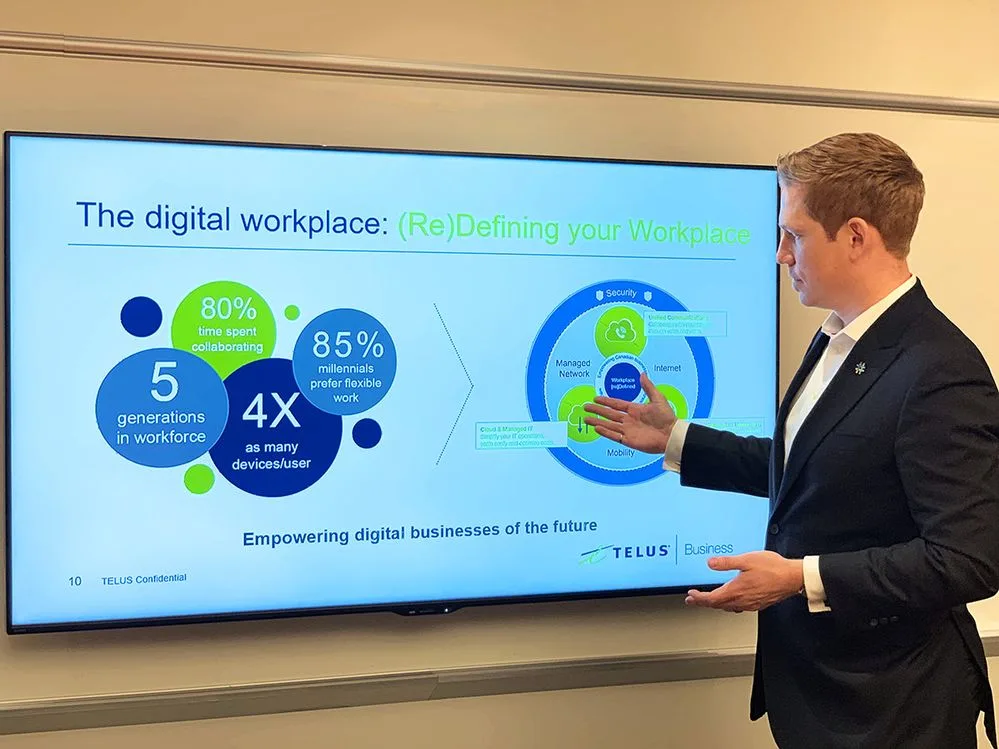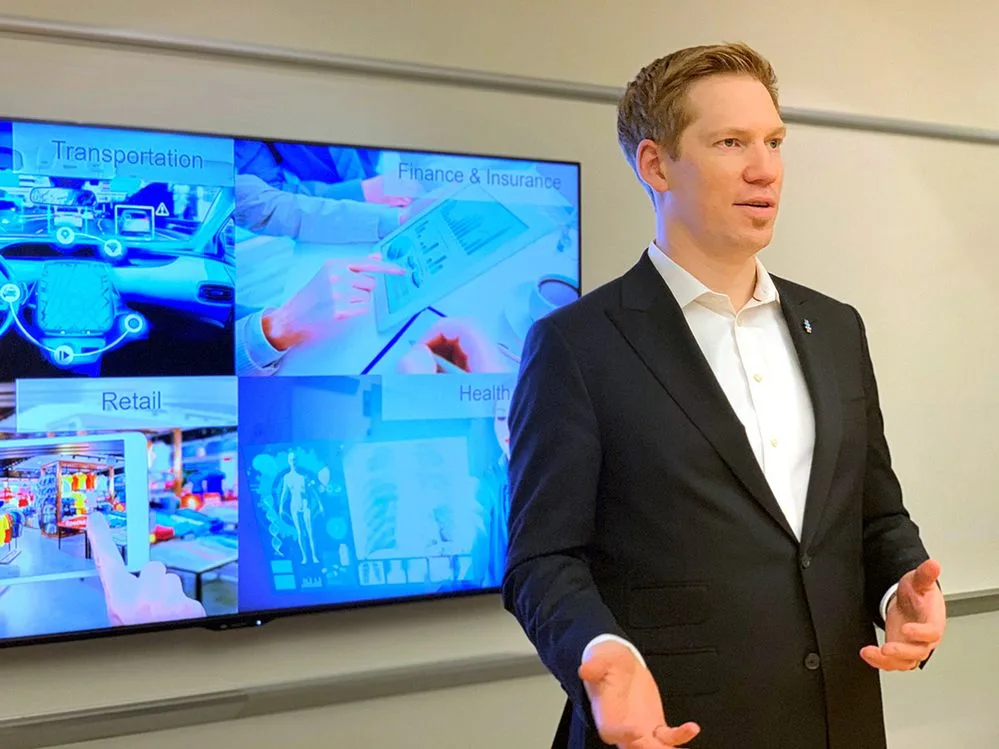
Future-proofing your business for sustained growth
Other · Jan 29, 2019
Craig Thornton, Vice President of Business Solutions at TELUS, recently spoke to a sold-out audience at the Toronto Region Board of Trade. His appearance was timely, given the Government’s new capital investment tax incentives that encourage companies to address a global development: digital transformation is redefining every aspect of the workplace. Thornton presented the evidence, implications and path Canadian businesses must take to thrive in this new reality.
As technology gives rise to an evolving group of industry titans, the lifespan of the average business is now a mere 14 years, almost 60% shorter than it was five decades ago. To endure in the digital era, businesses must enable their employees to operate at the escalating speed of customer demand.
With that in mind, Thornton imparted his guidance on the three most important areasbusinesses should focus on today, in order to future-proof for sustained growth into the next decade.
1. Driving your competitive advantage with talent and culture
Looking within one’s organization, there are three distinct classes of employees:

Thornton revealed how significant the impact of disengaged employees is. He referenced an Aon Hewitt study that found a single disengaged employee costs their company an average of $10,000 in lost yearly profit, and Gallup’s conclusion that disengaged employees cost the Canadian economy $45-$55 Billion annually.
It serves to reason, Thornton deduced, that creating actively engaged employees is the main challenge and main benefit of digital transformation.
Looking inward, 8 years ago, actively engaged employees accounted for just over 50% of TELUS’ workforce. Today, over 80% of its workforce is comprised of actively engaged employees. Thornton noted the size of this group as being a primary factor in attracting and keeping top talent, which directly impacts profitability. Talented and skilled people, the lifeblood of any successful organization, choose companies that provide the greatest opportunity to overachieve, which means being enabled anywhere, anytime, on any device, with likeminded colleagues.
When a member of the audience asked how TELUS compared to others, Thornton shared that TELUS ranks in the top 10% of companies globally. With the proper technology and supporting behaviours in place, TELUS achieved a high level of engagement within its workforce, which afforded its leadership team the latitude to focus on sub-drivers of productivity. TELUS attracted top talent, built an innovation-driven culture, mobilized initiatives faster and realized substantial growth – translating to a 3-fold increase in its market valuation since beginning its digital transformation journey.

2. The importance of flexible work
Thornton emphasized that the majority of employees thrive when offered flexibility in how and where they can complete their work. When a company provides
tools that allow work-life balance
– an ability to work from home to accommodate an important doctor’s appointment, or to help a parent watch over an unwell child, as examples - an employee feels respected, trusted and enabled to produce.An attendee shared that collaboration technology extends beyond good communication. Having face-to-face meetings without having to fly or drive saves their company a great deal of money and time. Allowing employees a mix of office and home days reduced their commuting headaches and has led to increased productivity, with fewer delays and less stress.
Thornton agreed, and noted TELUS recognizes the value, as well. For most employees, always being in the office doesn’t offer proper work-life balance and quiet space to be productive, while always being away from the office means less opportunity to build buzz and comradery amongst employees.
Another attendee shared that their space has been redesigned to facilitate collaboration among employees when in the office.
Thornton commended encouraging employees to form and re-form their environment to accommodate the collaboration needs of various projects. He also added that companies who can’t compete by offering the highest salary in market can win major points with employees by offering flexible workstyles and work from home options.
An attendee expressed fear that employees won’t be active when they are away from the office and not being watched.
Thornton countered that if an employee is disengaged at home, they are disengaged at the office as well.
Processes, tools and governance are the keys to redefining your workplace
. Leadership must provide strong technology, enable cohesive teams and grade their employees on outcomes. TELUS has made these changes, and the results are impressive:- $50M/year in real estate savings, providing employees with the option to choose where and when they work on certain days, and reducing space needed for always-in employees;
- Absenteeism is 45% lower compared to unionized workers, and 33% lower than the management professional average in Canada;
- A 178% increase in resumes received, opening hiring to a larger and more qualified talent pool;
- A 34% increase in employee engagement;
- The lowest churn rate in the industry for the past 5 years (under 1%).
By giving employees collaboration tools, greater latitude regarding where they work and changing evaluations to assess objectives reached, TELUS employees are well-equipped to produce for colleagues, shareholders and the evolving needs of their customers.

3. Embracing network and collaboration tools to ensure sustained growth
Thornton recognizes companies mean well in verbalizing desired changes, but struggle immensely with execution. They struggle because digital transformation is not just about changing technology - everything around that technology must adapt to allow progress.
The workforce is evolving. Within the next two years, 50% of the Canadian workforce will be millennials. They are more digitally connected and possess more devices than any generation before them. Flexible work driven by anywhere, anytime collaboration is going to produce more success for businesses than they imagine.
Thornton outlined two core solutions every business needs in order to compete at the highest level.
A strong network across physical and virtual locations
Your network connectivity
, fixed and mobile, underpins your transformation - supporting employees wherever, whenever, however they need to be productive.Unified Communications solutions
Collaboration solutions
keep physical and virtual teams connected - enhancing communication through a mix of voice, video and integrated messaging.Thornton noted that the core solutions supporting digital transformation are not something to install and walk away from. Each company must think about how the tools they put in place can coexist and complement one another.
One attendee suggested that behavior is the great divide today. Smart technology is easily adopted by the younger generation, but underlying governance regarding what behaviours are expected when using each digital solution puts all employees on an equal footing, and increases everyone’s willingness to embrace them.
This sentiment was confirmed by another attendee, who used a non-workplace example of technology and behaviour driving an unexpected outcome. His son completes university project work with peers over Instagram. It doesn’t seem like the platform is conducive to project work, but it’s free to use, readily available, allows group messaging, has defined and understood user behaviours, and is a platform his son and peers feel agile on. He agreed with Thornton that technology plus motivation creates new, dynamic ways of collaboration and productivity.
Another attendee connected its relevance to business, noting that customers are further ahead, and companies must be quick to embrace platforms customers prefer to communicate on.
“Where will technology take us?” Thornton queried the audience. An
everywhere network
with the quickest speed and lowest latency will change entire industries in the near future. 5G will empower mobility
and the Internet of Things
technology in incredibly innovative ways. As an example of its impact on healthcare, 5G will enable remote diagnosis and remote surgeries. He asked all attendees to think about how a more robust network will impact their respective industries.Thornton left the audience with three actions they must take to embrace their own digital evolution:
Behaviour
Balancing the interpersonal buzz created by working in the office vs. the productivity enabled by working away from it is something leadership teams should review. It should vary based on how each team operates. Setting expectations around what is acceptable within the team or business is critical to long-term success.
Governance
The same rules need to apply from the top to the bottom of the organization, and must be evangelized by your leadership team. Prove through words, training and technology that employees are trusted and supported. Embed expectations in organizational policies, where possible.
Technology
Pick the right technology and partner to help advance your digital transformation. Create a continuous internal feedback loop, because what your employees need from their technology will change over time, and being able to scale quickly with an informed partner will accelerate your evolution.
Seeking to future-proof your business? Learn how
TELUS workplace solutions provide a significant opportunity for your business
, or connect with a solutions expert
who can help you build a roadmap for your own digital transformation.Authored by:
Josh Bower
TELUS Business


